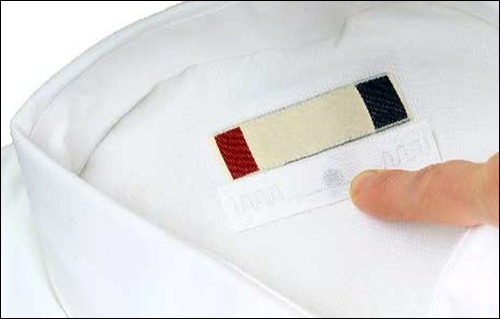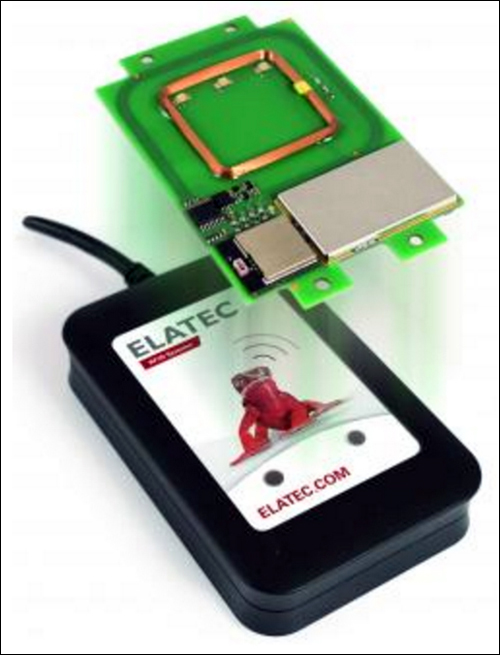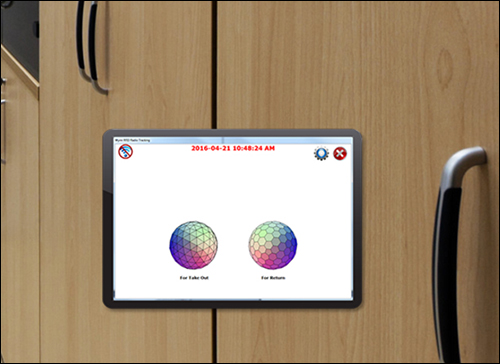Mar 16, 2017The following are news announcements made during the past week by the following organizations: Datamars; STMicroelectronics; Elatec; GAO RFID; NXP Semiconductors, Canonical; and CEL.
Datamars Releases UHF RFID Transponder for Industrial Laundry
Datamars, a supplier of unique-identification solutions specializing in radio frequency identification, has announced the release of a new ultrahigh-frequency (UHF) RFID transponder. The LaundryChip 401 is the latest addition to Datamars' LaundryChip family, a transponder line specifically designed for the industrial laundry sector.
"Nowadays, our customers—industrial laundries, textiles rental companies, hospitals and hospitality chains—need transponders not only able to endure the harshest industrial laundry conditions but also as small as possible in order to easily embed them in the finest flat linen and garment items," said Mr. Riccardo Mazzolini, Datamars' textile ID general manager, in a prepared statement. "We have responded by introducing our slimmest UHF transponder ever, keeping, and even improving, the mechanical resistance and best-in-class electronic performance that characterizes our LaundryChip family."
Compared to Datamars' 301 UHF transponder line, the thickness has been halved for the 401, and its width has been reduced by 33 percent. The transponder complies with the ISO 18000-6C standard and is resistant to high temperatures. It can endure up to 60 bar of pressure, is built to withstand the harsh conditions of laundry environments, and is capable of bulk-reading thousands of pieces and being read from distances of up to 6 meters (19 feet).
Soft, flexible and slim, the transponder can be inserted into small, flat linen items, such as pillowcases or napkins, as well as into fine garments. Its small size enables a new set of applications, the company reports, ranging from tracking luxury linens to identifying private garments. The LaundryChip 401 is available in three versions, depending on the application method: 401 Source Tagging (to be inserted directly into a hem), 401 Patchable (heat-sealable) and 401 In Pouch. Furthermore, it is laser-markable with an Electronic Product Code (EPC).
"The launch of this next generation transponder family is another important milestone for Datamars," said Julien Buros, Datamars' textile ID product and services director, in the prepared statement. "The 401 achieves a drastic reduction of physical dimensions while reading performance reaches new heights, especially in high density bulk. The 401 completes our high-performance UHF LaundryChip portfolio, widely enlarging its use in both the flat linen and the garment segments. Slimmer and stronger than ever, it can be embedded in every kind of textile and meets every kind of application requirement."
The new transponder will begin shipping in May 2017.
STMicroelectronics Issues NFC Reader, Kit for Contactless Applications
STMicroelectronics (ST) has combined its ST25R3911B Near Field Communicator (NFC) reader IC and STM32L476RE ultra-low-power microcontroller in its ST25R3911B-DISCO discovery kit, accelerating time to market for contactless applications. The board provides a reference for RF circuit layout and, with the included STM32 MCU software, can be quickly up and running as a high-frequency (HF) reader or NFC initiator.
The kit contains the company's ST25R3911B NFC reader IC, which offers differentiating features to help simplify design, streamline manufacturing and improve user experiences. Features for optimized power consumption include Dynamic Power Output, which avoids wasting energy by supplying the minimum amount of energy required to communicate with a target—an advantage for portable devices and payment terminals. Capacitive wake-up allows a card's presence to be detected, while drawing less than 5µA in sleep mode to preserve battery energy in equipment such as hotel card-key readers. Inductive wake-up is also supported.
The ST25R3911B RF receiver is approximately five times more sensitive than typical devices, the company reports, while up to 1.4 watts of output power allow for extended range without requiring an additional amplifier. Automatic Antenna Tuning (AAT) enables original equipment manufacturers (OEMs) to fine-tune the antenna settings of end-user equipment on the production line. In addition, the ST25R3911B enables a single-chip solution for Very High Bit Rate (VHBR) operation, which boosts download speeds from 848 kilobits per second to 6.8 megabits per second, making it suitable for use with e-government systems, including passports.
All major contactless and RFID standards are supported, including the ISO 18092 (NFCIP-1) Active P2P, ISO14443A, ISO14443B, FeliCa and ISO 15693 contactless standards. This enables such applications as ticketing, asset tracking, device authentication, sensor-data collection and access control.
The companion STM32L476RE ultra-low-power microcontroller on the board features the 80 MHz ARM Cortex-M4 core with DSP extensions and floating-point unit, and achieves power savings through features such as smart architecture with FlexPowerControl, dynamic voltage scaling, and seven power-management modes with sub-mode options. An embedded memory protection unit enhances application security. The kit helps developers leverage the strengths of the MCU and reader IC together, and connects with the STM32 ecosystem, including sample code, IP blocks and expansion boards.
ST launched its new NFC-reader discovery kit at this week's Embedded World event, held in Nuremberg, Germany. According to the company, the kit will be ready to order from distributors or at st.com following the exhibition, priced at $49.
Elatec Proximity Reader Combines RFID, NFC and Bluetooth Functionalities
Elatec's TWN4 MultiTech 2 Bluetooth Low Energy (BLE) RFID reader supports nearly all current ISO and other RFID technologies in use worldwide for 125 kHz, 134.2 kHz and 13.56 MHz. Supported technology families include MIFARE, HID, LEGIC, NFC Forum, HITAG and EM4xxx, as well as exotic tags such as Calypso and Felica.
The reader can be deployed in applications allowing or requiring identification with mobile phones. Its ability to communicate via Near Field Communication (NFC), as well as via BLE, makes it compatible with most popular smartphone systems, the company reports, including Android, IOS and Microsoft Windows Mobile.
The TWN4 MultiTech 2 BLE is a flexibly configurable device. Its settings can be altered depending on the specific requirements of a given project or application. For example, it could be set up to read only the third sector of a MIFARE Classic card, or to decode the printed number from an HID Prox card. This type of configuration can be saved to a TWN4 Configuration Card, which can later be used to apply the same configuration on another Elatec RFID reader.
Because TWN4 Configuration Cards are contactless, the firm explains, there is no need to unmount the reader from the machine in which it is integrated, nor to deal with its software or hardware, thus saving time—especially with regard to large projects. In order to guarantee the application's security, a command preventing further wireless modification of the reader's setup can be submitted as well.
The TWN4 MultiTech 2 BLE is designed as a plug-and-play all-in-one proximity reader, and is available as a PCB or with housing. It can be integrated in various industrial and office applications without any extra steps, thanks to its wide technological support and worldwide technical approvals. Application areas for this reader include time attendance, managed print services, access control, single sign-on, industrial computers and fitness equipment.
GAO RFID Produces Smart Cabinet Checkout System
GAO RFID has introduced an integrated business solution for tracking the checkout and return of assets from within a cabinet. The company's Smart Checkout Cabinet is a self-service system designed for businesses that require employees and contractors to borrow assets in order to complete their day-to-day tasks.
Assets such as portable tools, safety items, technology devices and keys can be inventoried, checked out and tracked automatically in real time, using RFID technology that works with any cabinets fitted with an electronic strike. As a result, employees and contractors can check out and return items, while the system's flexible reporting features provide managers with visibility into asset use.
This integrated solution optimizes the management and monitoring of important assets by improving the speed and functionality of the tracking process. Compared to other traditional approaches for tracking the checkout and return of assets, the Smart Checkout system offers an automated method for reducing the risk of loss and theft, while assigning accountability for their use. The solution offers a simple workflow, the company reports. Item removal and return are automatically recognized by the cabinet, and the system summarizes the items borrowed, assigns them to a particular user and records the transaction in the database.
The Smart Checkout System for Cabinets is available in two versions: Tap (contact for required checkout) and Air (contactless checkout). It includes a badge reader, an item reader, access badges, asset tags, an industrial-grade touchscreen and GAO RFID's Smart Cabinet Checkout software.
NXP, Canonical to Demo IoT Gateways at Embedded World
NXP Semiconductors and Canonical have collaborated to port Ubuntu Core to the LS1043A, a quad-core system-on-chip targeted at Internet of Things gateways and networking equipment. With this combination, device manufacturers gain a platform with which to build high-throughput IoT gateways.
Ubuntu Core has been used in a variety of devices from IoT gateways to network equipment. IoT gateways benefit from the wide support of IoT protocol available on Ubuntu, and let developers utilize the edge-computing capabilities offered by the LS1043A to run advanced analytics and artificial-intelligence models. Embedded networking products can run standard Linux applications such as Quagga or Sonic. Ubuntu Core thus makes full use of the LS1043A's network and IO features, such as packet acceleration, to simultaneously support high bandwidth traffic to smart devices over 802.11ac, as well as IoT data collection via Bluetooth LE, Thread, ZigBee or other low-power wireless standards.
Ubuntu Core allows device manufacturers to use the Snaps cross-platform Linux packaging format to build applications. Snaps offers a number of features for device manufacturers throughout the software-management lifecycle, from development to deployment and from security to business models.
Snaps allows developers to create, package, test and distribute self-contained applications based on thousands of existing Ubuntu and Linux libraries. This means device manufacturers can reduce development time, the company explains. Snaps can also help with monetization, as the system can be deployed within a branded store.
"We are pleased to be working with Canonical to demonstrate the full IoT capabilities of Ubuntu Core on the NXP LS1043A," said Richard House, NXP's VP of software development and digital networking, in a prepared statement. "Ubuntu Core will provide our customers with a great tool to go from development to production on the scalable Layerscape family of SoCs."
The LS1043A is part of the QorIQ Layerscape family, which offers additional security via Trust Architecture. According to the company, this complements security features associated with Snaps, such as read-only images, authentication of application origin, confinement, isolation and transactional updates. As the Ubuntu Core image is built from the ground up using Snaps, the entire device stack can benefit from tools to continuously update the stack and roll-back in case of update failure, thereby ensuring the devices' security and integrity.
CEL Unveils Article for IOT Design Engineers
CEL recently published an article titled "Alphabet Soup: Understanding IoT Acronyms and How to Compare Them," by Matt Smith. The article is intended to help product managers and IoT design engineers understand the ever-changing and complex maze of communication standards and protocols involved with the Internet of Things.
One of the most important decisions developers face is which communication protocols to choose, the company reports. This decision impacts hardware choices, as well as what devices and functionality are available. Communication protocols need to be grouped together, CEL reports, noting that only certain protocols can connect to each other.
CEL's technology-agnostic blog is intended to address these and other issues. "As the Internet of Things (IoT) industry continues to expand, new information on emerging best practices, technical specifications and design considerations continues to flood the market," Smith wrote in the article. "Here at CEL, one of our priorities is helping you navigate through the deluge of information and identify which technology choices will have the biggest positive impact on your upcoming IoT plans. With that in mind, my next several posts will aim to help your decision-making process by explaining the existing technologies and attempting to demystify the ocean of IoT protocols. I'll go through a framework for categorizing the various technologies and explain some criteria on how to compare and evaluate these."
Smith's blog also features an article titled "How I Stopped Worrying and Learned to Love the Gateway." This piece offers a discussion about the ideal IoT network architecture, and explains why Smith advocates using intelligent, on-premises gateways to manage local and cloud-based communication.




